What is Strategic Planning? Definition, Benefits, and Flaws Easy Explained
Understanding Strategic Planning it’s importance in the planning process is an important step toward successful planning. So let’s have a look at the definition, the importance, the benefits and the potential flaws of strategic planning as one of the 4 types of planning.
Definition of Strategic Planning
Strategic planning is an organization’s process of defining its strategy or direction, and making decisions on allocating its resources to attain strategic goals.
Wikipedia – Strategic Planning
That is the definition Wikipedia gives on its page about Strategic planning. I would make the definition a bit broader as it applies to organizations and individuals alike.
Strategic Planning is a systematic process to define long-term goals and create a roadmap to achieve them.
Thus, it is the process of setting goals, defining objectives, and mapping out a clear course of action to achieve them. Additionally, it can help to align every aspect of your life or department in an organization toward a common goal or vision. This ensures that every decision and action contributes to an overarching mission in the long run.
The first steps in the strategic planning process involve analyzing the status quo aka the current state of things. Then you pass over to identifying potential opportunities that can improve your status, but also challenges that may occur. Finally you prioritize your next steps and aligning your existing resources to maximize your chances of success.
Importance of Strategic Planning
While it often may seem like an additional step in the planning process – that could easily been skipped – the key benefits of strategic planning shouldn’t be neglected. By analyzing internal and external factors, you can identify strategic objectives and formulate action plans. This process then helps allocate resources, make informed decisions, and adapt to changing circumstances.
It is a vital process that holds immense significance for individuals and organizations alike. By understanding the importance of strategic planning, individuals and organizations can proactively shape their future and maximize their chances of success.
Potential Benefits
Goal Alignment: It helps individuals and organizations align their actions and decisions with their long-term goals. It provides a clear direction and purpose, ensuring that efforts are focused on achieving desired outcomes.
Resource Allocation: It helps optimize the allocation of resources, including financial, human, and time resources. It allows individuals and organizations to prioritize initiatives, align activities and strategies, make informed decisions on resource allocation, and avoid wasteful or inefficient practices.
Adaptability: By considering various scenarios and potential challenges, it helps identify risks and opportunities, and it enables individuals and organizations to adapt to changing circumstances, allowing for proactive adjustments and mitigating potential threats.
Decision-Making Framework: It provides a structured framework for decision-making. It helps individuals and organizations consider different alternatives, evaluate their potential impact, and make informed choices based on available information and strategic objectives.
Communication and Alignment: It promotes communication and alignment within an organization or among individuals working towards a common goal. It helps create a shared understanding of objectives, expectations, and the overall strategy, fostering collaboration and teamwork.
Potential Benefits
- Alignment of different goals
- Optimal usage of resources
- Awareness of potential changes
- Structured decision-making
- Improved communication

Potential Flaws
Rigidity: Especial traditional planning may become too rigid and inflexible, unable to respond effectively to dynamic environments or unexpected disruptions. To avoid this, the agile planning approach has gained recognition in recent years.
Lack of Execution: Strategic plans are only effective if they are implemented properly. Poor execution can undermine the benefits of outstanding planning. Read more on how to align your daily routines with your overall goals in “Categories that will actually help you prioritize your Daily Routines” and how to reach your goals by transforming your plans into routines.
Overemphasis on Analysis: Excessive analysis and planning can lead to analysis paralysis, delaying decision-making and action.
Limited Predictability: While it aims to anticipate the future, it cannot predict all outcomes accurately, and unexpected events may disrupt planned strategies.
To overcome potential flaws, individuals and organizations should embrace flexibility, encourage proactive execution, strike a balance between analysis and action, and regularly review and adjust strategic plans based on real-time feedback and changing circumstances.
Potential Flaws
- Rigidity and inflexibility
- Lack of execution
- Overemphasis on analysis
- Limited predictability

Conclusion:
In conclusion, strategic planning is a vital process that helps individuals and organizations define their long-term goals and develop a roadmap for success. It provides clear direction, aligns actions with goals, optimizes resource allocation, enables adaptability, and establishes a decision-making framework.

However, it can have flaws, including rigidity, poor execution, overemphasis on analysis, and limited predictability. To overcome these flaws, flexibility, proactive execution, balanced analysis and action, and regular plan review are essential.
By understanding the importance of planning and addressing its potential flaws, individuals and organizations can effectively shape their future and increase their chances of success.
Want to know how strategic planning fits into the 4 Stages of Planning? Read here






